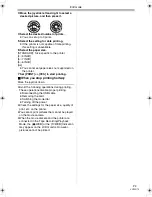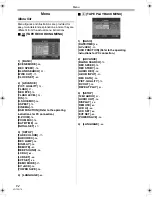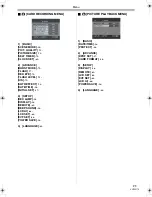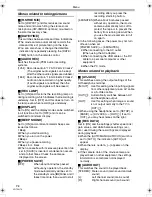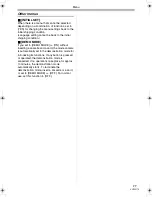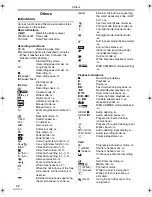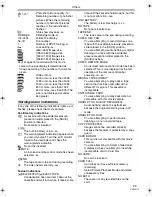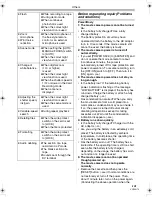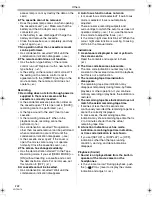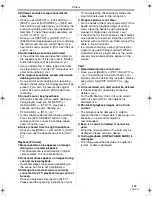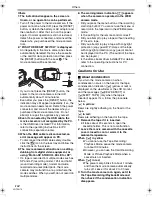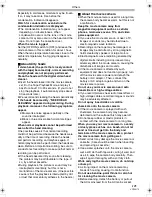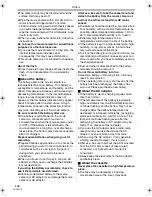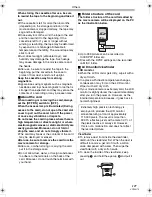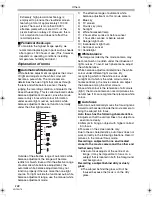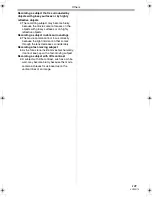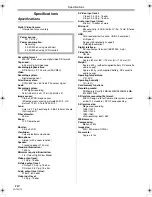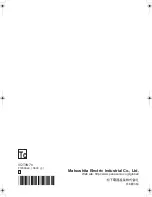
Others
107
VQT0N70
When storing the cassette after use, be sure
to rewind the tape to the beginning and take it
out.
≥
If the cassette is left for more than 6 months
(depending on the storage condition) in the
movie camera or stopped midway, the tape may
sag and be damaged.
≥
Once every 6 months, wind the tape to the end
and then rewind it to the beginning. If the
cassette is left for 1 year or longer without
winding or rewinding, the tape may be deformed
by expansion or shrinkage attributable to
temperature and humidity. The wound tape may
stick to itself.
≥
Dust, direct sunlight (ultraviolet rays), and
humidity may damage the tape. Such usage
may cause damage to the movie camera and
the heads.
≥
After use, be sure to rewind the tape to the
beginning, put the cassette in the case to
protect it from dust, and store it upright.
Keep the cassette away from strong
magnetism.
≥
Apparatuses using magnets such as magnetic
necklaces and toys have magnetic force that is
stronger than expected, and they may erase the
contents of a recording or may increase noise.
ª
About the card
When inserting or removing the card, always
set the [OFF/ON] switch to [OFF].
When the access lamp is illuminated (During
access to the card), do not open the card slot
cover to pull out the card, turn off the power,
or cause any vibrations or impacts.
Do not leave the card in places where there is
high temperature or direct sunlight, or where
electromagnetic waves or static electricity are
easily generated. Moreover, do not fold or
drop the card, and do not strongly vibrate it.
≥
The card may break or the contents of the card
may be destroyed or erased.
After use, be sure to remove the card from the
movie camera for storage.
≥
After use, or when storing or carrying the card,
put it in the storage case.
≥
Do not allow dust, water, or foreign substances
to adhere to the terminals on the back of the
card. Moreover, do not touch the terminals with
your hand.
ª
Folder structure of the card
The folder structure of the card formatted by
the movie camera will be displayed on the PC
as the illustration below.
≥
Up to 999 pictures can be recorded on
100CDPFP folder etc.
≥
Files with the DPOF settings can be recorded
on MISC folder.
ª
LCD monitor/viewfinder
LCD monitor
≥
When the LCD monitor gets dirty, wipe it with a
dry soft cloth.
≥
In a place with drastic temperature changes,
condensation may form on the LCD monitor.
Wipe it with soft dry cloth.
≥
If your movie camera is extremely cold, the LCD
monitor is slightly darker than usual immediately
after you turn the power on. However, as the
internal temperature increases, it goes back to
normal brightness.
Viewfinder
≥
To remove dust from inside the viewfinder,
dismount the viewfinder first. When the dust is
difficult to remove, get rid of it with a cotton
swab dampened with water. Then wipe the
viewfinder with a dry cotton swab.
≥
To clean the inside of the viewfinder, keep
pressing
1
and hold the
eyecup
2
and pull it
out.
Extremely high precision technology is
employed to produce the LCD monitor
screen featuring a total of approximately
113,000 pixels. The result is more than
99.99% effective pixels with a mere 0.01% of
the pixels inactive or always lit. However,
this is not a malfunction and does not affect
the recorded picture.
256
1
2
GS250GC.book 107 ページ 2004年12月18日 土曜日 午後1時35分

